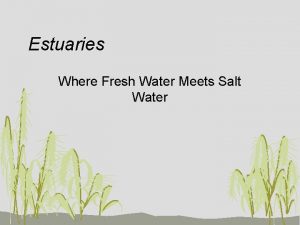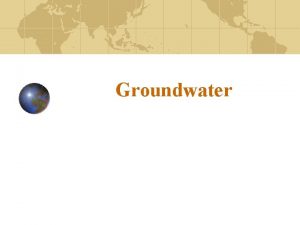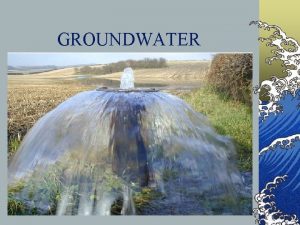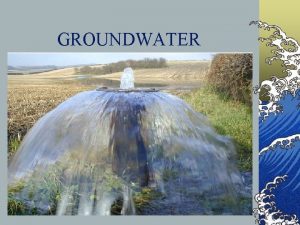Groundwater Groundwater Most of the fresh water that









- Slides: 9

Groundwater

Groundwater • Most of the fresh water that is available for human use cannot be seen, as it exists underground. • When it rains, some of the water that falls onto the land flows into lakes and streams. But much of the water percolates through the soil and down into the rocks beneath. • Groundwater is the water that is beneath the Earth’s surface.

Groundwater • As water travels beneath the Earth’s surface, it eventually reaches a level where the rocks and soil are saturated with water. This level is known as the water table. • In wet regions, the water table may be at Earth’s surface. But in deserts, the water table may be hundreds of meters beneath Earth’s surface. • The water table has peaks and valleys that match the shape of the land above. Groundwater tends to flow slowly from the peaks to the valleys.

Aquifers • An aquifer is a body or rock or sediment that stores groundwater and allows the flow of groundwater. They are an important water source for many cities. • The water table forms the upper boundary of an aquifer, and most aquifers consist of materials such as rock, sand, and gravel that have a lot of spaces where water can accumulate. • Groundwater can also dissolve rock formations, filling vast caves with water, creating underground lakes.

Porosity • Porosity is the percentage of the total volume of a rock or sediment that consists of open spaces. • Water in an aquifer is stored in the pore spaces and flows from one pore space to another. • The more porous a rock is, the more water it can hold.

Permeability • Permeability is the ability of a rock or sediment to let fluids pass through it open spaces or pores. • Materials such as gravel that allow the flow of water are permeable. Materials such as clay or granite that stop the flow of water are impermeable. • The most productive aquifers usually form in permeable materials, such as sandstone, limestone, or layers of sand gravel.

Recharge Zone • To reach an aquifer, surface water must travel down through permeable layers. • This is called the RECHARGE ZONE • Recharge zones are environmentally sensitive to pollution. • Any pollution in a recharge area will also enter and contaminate an aquifer

Recharge Zone • The size of the recharge zone is affected by the permeability of the surface above the aquifer • Man-made structures act as impermeable layers and therefore communities must carefully manage recharge zones so as to account for the slowing of water reaching the aquifer

Accessing Groundwater • There are several ways to access our groundwater. • The most common way is to dig a well, which is a hole dug/drilled deep enough to reach groundwater. • Wells are a more reliable source of water than surface water. Well water can be filtered and purified as it flows through the ground.

















